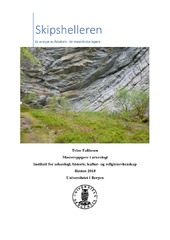| dc.description.abstract | Skipshelleren ble utgravd i 1930-1931, og en stor mengde osteologisk materiale ble samlet inn. Siden utgravningen har det osteologiske materialet blitt gjennomarbeidet og identifisert, hvor flere har nyttet materialet i videre forskning. Fiskebeinene som ble samlet inn fra de senmesolittiske kontekstene i helleren har derimot fått liten oppmerksomhet sammenlignet med pattedyrbeinene. Denne avhandlingen tar for seg erverv i senmesolitikum, med utgangspunkt i fiskebeinene fra Skipshelleren. Målet med oppgaven var først å gjennomgå stratigrafien i Skipshelleren, for å utskille sikre enheter som utgjorde rammen for en ny gjennomgang av fiskebeinene. Deretter ble det utarbeidet en liste over identifiserte fiskearter med NISP tilhørende de sikre kontekstene. Materialet blir undersøkt kildekritisk i et forsøk på å vurdere den kulturhistoriske verdien, samtidig som det undersøkes hvilken informasjon fiskebein kan bidra med i en vurdering av erverv og bosted. | en_US |
| dc.description.abstract | In this paper I will look at the rockshelter site Skipshelleren. The aim has been to explore the settlement pattern in the late Mesolithic, with basis in fishbones. I wanted to examine the potential of the information I could get from the fishbones, and whether this material would yield information regarding fishing methods, the functional use of the site and the seasons the site was used. In order to examine these questions, I examined the stratigraphy of the site and excluded unsecure units. To do so, I had to understand Johs. Bøe’s thoughts regarding the stratigraphy and masses, including how the “kulturhorisont” was composed and the layers within. After studying Bøes explanation in his published book (1934) I began checking his unpublished drawings of the layers. This excluded quite a few units. After this, C14-datings and artifact typology helped to secure the remaining units. The secure units made the basis for the exclusion of fishbones, which were already identified. The fishbones are a part of the osteological collection at the department of Natural history, University Museum of Bergen. To make a list over fishbones that belonged to the secure Mesolithic units, I sorted through the boxes containing fishbones and made a list of identified fish species with NISP. The identified species showed that the inhabitants of Skipshelleren had the knowledge and ability to fish in deep water for species like ling (Molva molva), which would probably require a boat. There had been fished several species, at least eighteen different, but the number of codfishes was considerable and indicates that this was the preferred fish. Other indications show that the inhabitants had a broad knowledge of fishing methods is the identified fragments also contain spiny dogfish (Squalus acanthias) and Atlantic blue fin tuna (Thunnus thynnus). The fishing methods were specialized and broad, a knowledge must have been passed down through generations. This tendency is also found at other sites from the same period, including the preference for codfishes. The identification of salmon (Salmo salar), Atlantic blue fin tuna, and Atlantic mackerel (Scomber scombrus) indicates that the rockshelter was used during the summer months, and analyses of some cod otoliths from the site shows that these codfishes were fished during the early spring or late winter. There is no indication that the site was used as a main settlement, but rather as a seasonal occupied site used to gather valuable resources. The archaeology in Skipshelleren is therefore concluded to be the result of a seasonal site use, used at different season during its long occupational phase (approximately 5600 – 4700 BC). | en_US |
